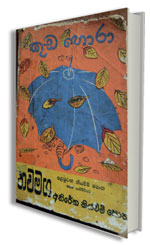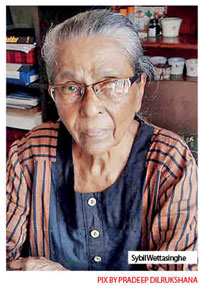Reply To:
Name - Reply Comment
 The robbery in Sybil Wettasinghe’s Kuda Hora or Umbrella Thief warrants no ‘charges’ against the culprit. Sixty years later after she ‘exposed’ this mischievous act of theft through her children’s page in the now defunct Janatha newspaper, the furry thief is in fact celebrated! Marking the 60th anniversary of this internationally acclaimed children’s publication, an exhibition of ceramics and umbrellas adorned with world famous illustrations from Kuda Hora will unfold on April 8th at the J.D.A Perera Gallery on Horton Place. The exhibition which will be open to the public from 9 am to 6 pm until April 10th, will also feature the life and work of Sybil Wettasinghe.Sybil nenda narrates to the the little known story behind well known Kuda Hora…
The robbery in Sybil Wettasinghe’s Kuda Hora or Umbrella Thief warrants no ‘charges’ against the culprit. Sixty years later after she ‘exposed’ this mischievous act of theft through her children’s page in the now defunct Janatha newspaper, the furry thief is in fact celebrated! Marking the 60th anniversary of this internationally acclaimed children’s publication, an exhibition of ceramics and umbrellas adorned with world famous illustrations from Kuda Hora will unfold on April 8th at the J.D.A Perera Gallery on Horton Place. The exhibition which will be open to the public from 9 am to 6 pm until April 10th, will also feature the life and work of Sybil Wettasinghe.Sybil nenda narrates to the the little known story behind well known Kuda Hora…
“Kosgama kuda nehe. Game minissu kuda dekalawath nehe….”

The opening lines of Sybil Wettasinghe’s Kuda Hora or Umbrella Thief, resonating the Kosgama dialect of an era gone by, with clipped short articulation, transports anybody to a rustic way of living. Kirimama and his fellow village folk are immortalized among the pages of this mater piece of a children’s book, together with their kesel kola and habarala kola which sheltered them against rains until Kirimama discovered the magic of an umbrella!
The mischievous monkey or wanduru muththa who is discovered to be the ‘thief’ of countless umbrellas Kirimama purchased from Colombo, had been enthralling many generations with his ‘grand act of theft’ for six decades and will continue to do so no doubt.
A theft exposed
 The robbery in Sybil nenda’s Kuda Hora warrants no ‘charges’ against the culprit. Sixty years later after she ‘exposed’ this mischievous act of theft through her children’s page- Kumaramandapaya in the now defunct Janatha newspaper, the furry thief is in fact celebrated. Marking the 60th anniversary of this internationally acclaimed children’s publication, which has even made its way to the Chihiro Art Museum Tokyo (which is home to the work of the world’s best children’s book illustrators) an exhibition of ceramics and umbrellas adorned with world famous illustrations from Kuda Hora will unfold on April 8th at the J.D.A Perera Gallery.
The robbery in Sybil nenda’s Kuda Hora warrants no ‘charges’ against the culprit. Sixty years later after she ‘exposed’ this mischievous act of theft through her children’s page- Kumaramandapaya in the now defunct Janatha newspaper, the furry thief is in fact celebrated. Marking the 60th anniversary of this internationally acclaimed children’s publication, which has even made its way to the Chihiro Art Museum Tokyo (which is home to the work of the world’s best children’s book illustrators) an exhibition of ceramics and umbrellas adorned with world famous illustrations from Kuda Hora will unfold on April 8th at the J.D.A Perera Gallery.
Ceramic comes alive
Walking through the doors of Midaya Ceramics in Makumbura, to the office of its Managing Director, Anura Warnakulasooriya, we stopped in our tracks to be mesmerized by Kirimama and his furry enemy turned friend smiling at us on an assortment of crockery! Throwing light upon Midaya’s move to translate Kuda Hora in print form to ceramics, its MD said that he was inspired by the Japanese Ceramic Art Designer and lecturer, Naohire Usui from the Joshibi University of Art and Design who has an association with his company and was here for six months.
Anura who takes forward the legacy of his family enterprise initiated by his father Dayasiri Warnakulasooriya in 1968, feels that everybody was at the right time at the right place to spearhead this exciting Kuda Hora venture. “We had no clue that Sybil’s Kuda Hora was marking its 60th anniversary this year and when we visited her to discuss the possibilities of doing ceramic work with her illustrations, she said why not do something related to Kuda Hora.”
Kuda Hora is born
Sybil nenda herself is a bundle of mischief, a fountain of wisdom and an epitome of youthful spirit. At 88, she remains the perennial seven-year-old as she loves to be called! “It is the child in me which had made all this possible,” reflects Sybil who recollects her birth of much loved Kuda Hora. Moving to Janatha from Lankadeepa, which was then a part of the Times of Ceylon Group, was a turning point in young Sybil de Silva’s life. Sybil not only came under the wings of stalwarts such as Denzil Peiris who encouraged her artistic pursuits, but became a subject of admiration by a “tall, shy, fair man” in her own words. The shy and fair man who turned out to be the chief sub editor of Janatha and later her husband - Dharmapala Wettasinghe, one day coaxed Sybil to write a story for children. “When I told him that I had never written stories, he insisted that surely a village lass must have plenty of experiences to narrate and as a second thought added, mama kiyanawata liyanna (write for my sake),” recalls a chuckling Sybil. Kuda Hora was thus born.
Monkeys and mangoes
 What inspires the plot is even more fascinating. “Believe me, nobody other than my father had an umbrella in our village Gintota and I was fascinated by the sight of village folk carrying kesel kola, habarala kola, gunny bags and even clay pots over their heads on rainy days. This kindled my interest to weave my plot around them,” “Monkeys were part of our daily lives in Gintota. They were such friends with us children, so much so they used to throw mangoes at us when we gesticulated for the fruit.” Young Sybil was suddenly distracted by a monkey one day who dashed off to her aththamma’s bedroom, snatched a face mirror and frantically climbed a breadfruit tree with it. It enthralled the young child who shrieked in delight. To Sybil’s mortification, her aunt made such a fuss that the monkey dropped the mirror and jumped off to another tree!
What inspires the plot is even more fascinating. “Believe me, nobody other than my father had an umbrella in our village Gintota and I was fascinated by the sight of village folk carrying kesel kola, habarala kola, gunny bags and even clay pots over their heads on rainy days. This kindled my interest to weave my plot around them,” “Monkeys were part of our daily lives in Gintota. They were such friends with us children, so much so they used to throw mangoes at us when we gesticulated for the fruit.” Young Sybil was suddenly distracted by a monkey one day who dashed off to her aththamma’s bedroom, snatched a face mirror and frantically climbed a breadfruit tree with it. It enthralled the young child who shrieked in delight. To Sybil’s mortification, her aunt made such a fuss that the monkey dropped the mirror and jumped off to another tree!
Scholarly praise
The fine blend of a plot she created with an umbrella and a monkey for the Janatha newspaper- her first attempt at writing a story was well received by her illustrious superiors including Denzil Peiris, Ernest Corea and Tarzie Vittachi. In 1954, the eminent Headmaster of the then Royal Primary, H.D Sugathapala who remained one of the most influential personalities on Sybil’s career, invited her to illustrate Kuda Hora in his famous Nava Maga series for primary children. Two years later, in 1956 the story was first published as a book by the Ceylon Apothecaries Company and as Sybil recalls, a special paper was imported by the company for this purpose. ‘Kuda Hora was the beginning of a new era in children’s literature. I recall with pleasure that I recognized the significance of the book on its first appearance…… Kuda Hora was the first Sinhala book to completely marry words and pictures.’ He goes on to note that the pictures in the book are ‘an accessory to the words’. ‘Through this accompaniment of the verbal and the visual, the child’s joy is sustained throughout.’
Going global
Translated into nearly ten languages, Kuda Hora was also honoured as the first and so far the only Sri Lankan work of writing to be published in Denmark. “I am flattered and humbled at the same time to be recognized by the land of none other than Hans Christian Anderson,” quips Sybil who considers Kuda Hora to be a watershed in her career. “I travelled the world with it attending some of the most prestigious literary festivals across the world and it indeed brought me good luck. The world came to know me through Kuda Hora.” In the early 80s, she received a letter from an unknown person inviting her to participate in Noma Concours Picture Book Illustrations Competition in Japan. Her pick was Kuda Hora and she did a new set of illustrations in colour for her entry. “When I received a cable from Japan three months later that I had won the third prize, I was speechless.”
Following this, Kuda Hora was published in Japanese by Fukutake Publishing Company in 1986. In the same year it won the prize for the Best Foreign Book published in Japan that year. In 1987 it was selected as the most popular children’s book by children of the Japan Children’s Library Association. Kayoko Yoneda, the Japanese Editor of the book has commented on the reasons for awarding it the Japan Special Prize which is awarded to translated books published by a Japanese publisher for Japanese people.
This ever green book which continues to travel the world todate is as ‘young as Sybil nenda’ herself. So much so Sybil Wettasinghe and Kuda Hora are synonymous. “Recently in Nugegoda town, a little boy was pointing at me and yelling, ‘anna anna kuda hora yanawa! (there goes the umbrella thief). I often ask myself if it is the monkey who is the actual thief or myself!”
Don’t we ask the same?